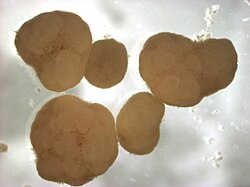The biological treatment of wastewater in the sewage treatment plant is often accomplished using conventional activated sludge systems. These systems generally require large surface areas for treatment and biomass separation units due to the generally poor settling properties of the sludge. Aerobic granules are a type of sludge that can self-immobilize flocs and microorganisms into spherical and strong compact structures. The advantages of aerobic granular sludge are excellent settleability, high biomass retention, simultaneous nutrient removal and tolerance to toxicity. Recent studies show that aerobic granular sludge treatment could be a potentially good method to treat high strength wastewaters with nutrients, toxic substances.
The aerobic granular sludge usually is cultivated in SBR (sequencing batch reactor) and applied successfully as a wastewater treatment for high strength wastewater, toxic wastewater and domestic wastewater. Compared with conventional aerobic granular processes for COD removal, current research focuses more on simultaneous nutrient removal, particularly COD, phosphorus and nitrogen, under pressure conditions, such as high salinity or thermophilic condition.
In recent years, new technologies have been developed to improve settleability. The use of aerobic granular sludge technology is one of them.

